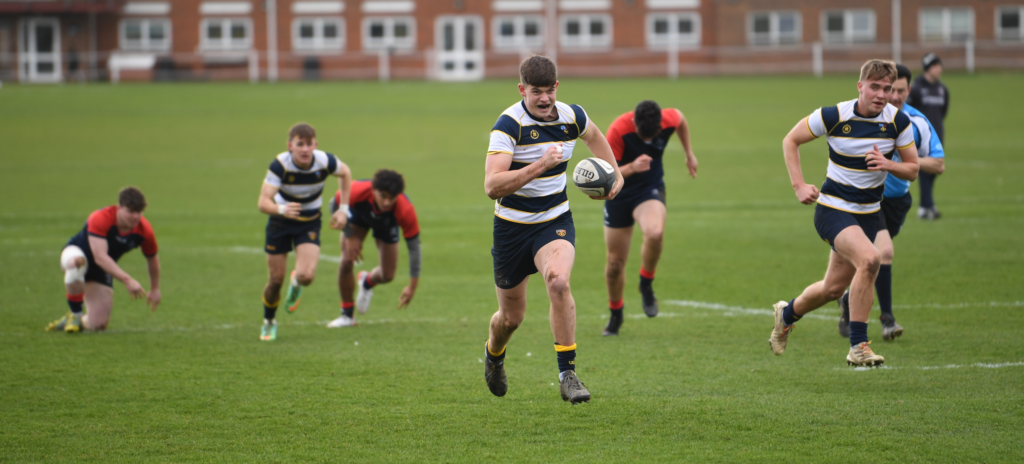Any rugby fan worth their mettle knows that free kicks are as integral a part of the sport of rugby as scrums and ruck. Free kicks offer teams an avenue to restart play whenever an opposing team commits a technical offense during the course of play. The word “free” in free-kick denotes the leeway a team is provided to decide how they are going to play it as it can result in a number of possible outcomes which can either favor or limit a non-offending team’s chances on both attack and defense. Put simply, as with everything else in rugby, strategy when taking a free kick is key.
Can you run a free kick in rugby? Yes, you can run a free kick in rugby. Actually, a free kick should not be confused with a penalty, which is much harsher. A team with possession may not kick directly for a goal in an attempt to score points from a free kick. It may also not score a goal via a drop kick unless an opponent touches the ball or tackles the player with possession of the ball first. Most teams prefer tapping the ball to themselves so that they can retain possession and make a more organized attack.

What the Rules Say
The Laws of the Game clearly lay out the guidelines regarding free kicks including which infractions warrant them, where they should be taken from, how players from the opposing team are supposed to conduct themselves, and the alternative remedies available for teams who are awarded free kicks.
Teams who are awarded a free-kick are usually given a mark through which they must tap the ball for play to resume. The rules stipulate that such a mark should be no less than five meters away from the goal line. This makes sense as both the attacking and defending team would not have enough room to either advance or attempt to intercept the ball at a shorter distance.
If the ball is in play, a free kick is usually awarded at the place the infringement occurs. If the infringement occurs outside the area of play if the ball is still in play, a free kick is to be taken at the 15-meter line parallel to where the infringement was committed.
Any ensuing infringements by the offending team before a free kick is taken are treated much more harshly. The non-offending team is allowed to advance 10 meters from the point of the original infraction and still retain possession of the ball.
Free Kick Options
Rugby rules offer the non-offending teams a number of options with regards to taking a free-kick. A team may opt to tap kick the ball to themselves to ensure that they maintain possession. This is done by either getting a player from the team to punt the ball into his own hands or placing the ball on the ground and kicking it over a small distance.
A non-offending team may also opt for a scrum and communicate the same to the referee through their captain. Standard scrum rules would then follow with the scrum-half said team being the one to introduce the ball into the scrum.
If a non-offending team has been awarded a free-kick at a lineout, the team may opt for a lineout (and throw the ball in) or choose a scrum at the same mark. A team may also opt to use any of the three types of kicks (a punt, place kick, or drop-kick) to resume play.
For a punt, the kicker (non-offending team player) would simply drop and kick the ball forward without it touching the ground. Should they opt for a drop kick, a player from the team would commence the play by holding the ball in his hands then dropping it to allow it to bounce lightly off the ground before kicking it forward.
A place kick is also an option for the non-offending team though it is rarely chosen since it would require a player from the team to kick the ball forward without getting it into touch as it would afford the team no tactical advantage (throw) at the following lineout. Place kicks require a player to place the ball on the ground (usually on a kicking tee) before sending it on its way.
Can You Charge a Free Kick in Rugby?
Yes. An opposing player (a player from an offending team) may charge at a free-kick provided certain rules of engagement are adhered to. The Laws of the Game state that once a free kick is awarded, the players from the offending team must retreat 10 meters toward their own goal line or until they reach their goal line (if it’s closer). This rule is to be observed regardless of whether the free kick is taken quickly.
Players from the offending team are required not to attempt to interfere, delay or obstruct the ball or the kicker in any way. Any attempts to throw, kick or obtain possession of the ball warrant further sanctions.
It is only when a kicker from the non-offending team proceeds to take the kick that players from the offending team are allowed to disrupt the play by either blocking the kick or tackling the kicker. If such actions are deemed to be fair and do indeed disrupt the play, the kick is ruled out and a scrum is formed at the mark with possession going to the opposing team.
A kicker also has to follow guidelines to ensure that fairness is maintained. Among them is to ensure that he/she takes the free kick without delay since any such action would cause a delay in the game. Any player from a non-offending team may take a free kick though most teams usually have a player who is tasked with that purpose.
The kicker may opt to either punt, drop-kick or place-kick the ball and is allowed to do so in any direction. What guides their option is their tactical need at the time, be it disrupting their opponent’s defense or gaining a better position on the pitch. The kicker’s teammates are also required to maintain a specific distance behind the ball until the ball is kicked.
